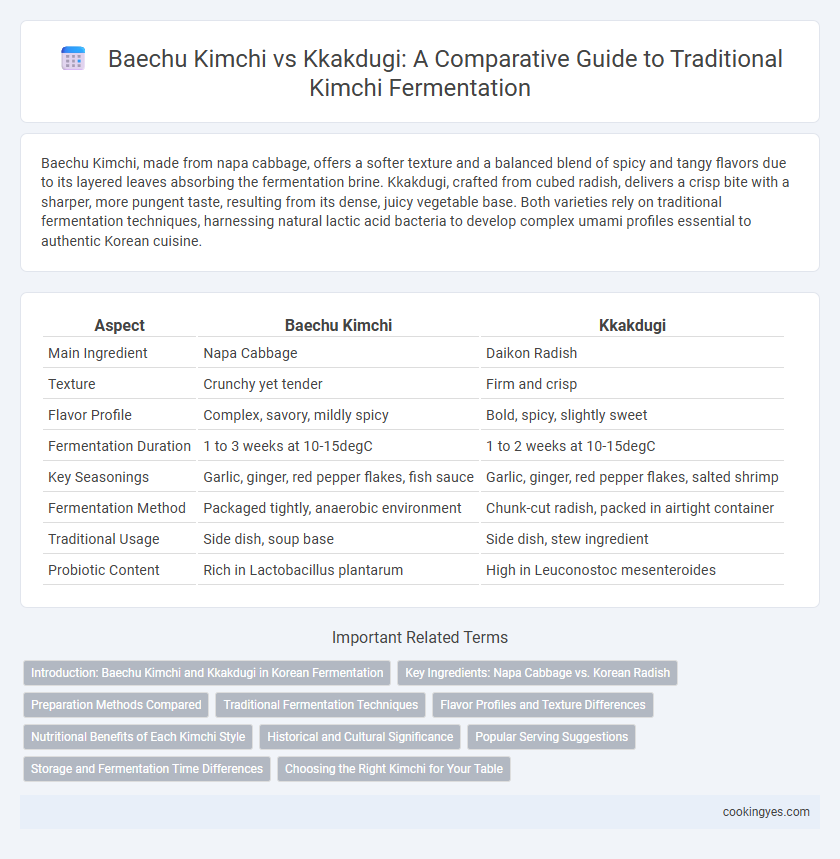Baechu Kimchi, made from napa cabbage, offers a softer texture and a balanced blend of spicy and tangy flavors due to its layered leaves absorbing the fermentation brine. Kkakdugi, crafted from cubed radish, delivers a crisp bite with a sharper, more pungent taste, resulting from its dense, juicy vegetable base. Both varieties rely on traditional fermentation techniques, harnessing natural lactic acid bacteria to develop complex umami profiles essential to authentic Korean cuisine.
Table of Comparison
| Aspect | Baechu Kimchi | Kkakdugi |
|---|---|---|
| Main Ingredient | Napa Cabbage | Daikon Radish |
| Texture | Crunchy yet tender | Firm and crisp |
| Flavor Profile | Complex, savory, mildly spicy | Bold, spicy, slightly sweet |
| Fermentation Duration | 1 to 3 weeks at 10-15degC | 1 to 2 weeks at 10-15degC |
| Key Seasonings | Garlic, ginger, red pepper flakes, fish sauce | Garlic, ginger, red pepper flakes, salted shrimp |
| Fermentation Method | Packaged tightly, anaerobic environment | Chunk-cut radish, packed in airtight container |
| Traditional Usage | Side dish, soup base | Side dish, stew ingredient |
| Probiotic Content | Rich in Lactobacillus plantarum | High in Leuconostoc mesenteroides |
Introduction: Baechu Kimchi and Kkakdugi in Korean Fermentation
Baechu Kimchi, made from napa cabbage, and Kkakdugi, prepared using cubed radish, are fundamental components of traditional Korean fermentation practices. Baechu Kimchi undergoes a layered fermentation process resulting in a complex, tangy flavor, while Kkakdugi offers a crisp texture and a mildly spicy taste due to radish's high water content and starch composition. Both contribute essential probiotics and unique nutrient profiles characteristic of Korean fermented foods, supporting digestive health and rich culinary heritage.
Key Ingredients: Napa Cabbage vs. Korean Radish
Baechu Kimchi features Napa cabbage as its main ingredient, providing a layered texture and a slightly sweet flavor ideal for traditional fermentation. Kkakdugi, on the other hand, relies on Korean radish, offering a crunchier texture and a sharper, more peppery taste that deepens during fermentation. Both vegetables' high water content and natural sugars support the growth of beneficial lactic acid bacteria crucial for authentic kimchi fermentation.
Preparation Methods Compared
Baechu Kimchi, traditionally made with Napa cabbage, undergoes a meticulous salting process to soften the leaves before being mixed with a paste of red pepper powder, garlic, ginger, and fish sauce for fermentation. Kkakdugi uses cubed Korean radish, which is salted and drained to remove excess water, then coated with a similar spicy seasoning blend but without the extensive leaf layering seen in Baechu Kimchi. The preparation difference lies in Baechu Kimchi's layering technique that promotes even fermentation, whereas Kkakdugi's uniform cubes allow for consistent flavor absorption throughout the fermentation period.
Traditional Fermentation Techniques
Baechu Kimchi and Kkakdugi both rely on traditional fermentation techniques involving lactic acid bacteria to develop their characteristic flavors and textures. Baechu Kimchi uses whole napa cabbage leaves salted and layered with seasonings, promoting fermentation primarily through indigenous Lactobacillus strains over several weeks. In contrast, Kkakdugi employs diced radish cubes, which ferment more rapidly due to higher surface area and moisture content, resulting in a crunchy texture and a tangier flavor profile unique to its fermentation process.
Flavor Profiles and Texture Differences
Baechu Kimchi, made from napa cabbage, features a complex balance of tangy, spicy, and umami flavors with a crunchy yet tender texture due to its layered leaves. Kkakdugi, crafted from cubed radish, delivers a sharper, more pungent taste with a crisp, firm bite that intensifies during traditional fermentation. Both utilize lactic acid bacteria fermentation, but Baechu Kimchi's moisture content creates a softer mouthfeel while Kkakdugi retains a refreshing crunch throughout the aging process.
Nutritional Benefits of Each Kimchi Style
Baechu Kimchi, made from napa cabbage, is rich in dietary fiber, vitamins A and C, and antioxidants that support digestive health and immune function during traditional fermentation. Kkakdugi, prepared with cubed radish, delivers higher levels of vitamin B complex and potassium, enhancing energy metabolism and electrolyte balance. Both kimchi styles provide probiotics essential for gut microbiota diversity, contributing to overall nutritional benefits in fermented foods.
Historical and Cultural Significance
Baechu Kimchi, made from Napa cabbage, has ancient roots dating back over 1,500 years and is deeply ingrained in Korean winter preservation traditions, symbolizing communal family bonding during kimjang season. Kkakdugi, a radish-based kimchi, emerged later in Korean history and holds regional importance, particularly in the southern provinces, reflecting local agricultural practices and flavor preferences. Both varieties contribute uniquely to Korea's cultural heritage by showcasing diverse fermentation techniques and seasonal adaptation in traditional Korean cuisine.
Popular Serving Suggestions
Baechu Kimchi, made from napa cabbage, is traditionally served as a side dish with Korean barbecue and steamed rice, enhancing savory meals with its tangy and spicy flavors. Kkakdugi, fermented cubed radish kimchi, is popular alongside hearty soups and stews like seolleongtang, providing a refreshing crunch and balancing rich broths. Both kimchi varieties reflect core elements of Korean cuisine, offering unique textures and fermentation depths that complement diverse traditional dishes.
Storage and Fermentation Time Differences
Baechu Kimchi, made with Napa cabbage, requires longer fermentation, typically stored at 0-5degC for 2-4 weeks to develop its signature tangy flavor and soft texture. Kkakdugi, composed of diced radish, ferments faster due to its denser texture, often ready within 1-2 weeks under similar storage conditions. The storage temperature and duration significantly impact lactic acid bacteria activity, influencing the taste and preservation of both Baechu Kimchi and Kkakdugi during traditional fermentation.
Choosing the Right Kimchi for Your Table
Baechu kimchi, made from napa cabbage, offers a classic, well-rounded fermentation flavor ideal for those seeking a versatile and traditional kimchi experience. Kkakdugi, crafted from diced radish, provides a crunchier texture and a slightly sharper tang, perfect for pairing with hearty soups and stews. Selecting the right kimchi depends on desired texture and flavor intensity, with baechu kimchi delivering complexity and kkakdugi enhancing meals with refreshing crispness.
Baechu Kimchi vs Kkakdugi for Traditional Fermentation Infographic

 cookingyes.com
cookingyes.com